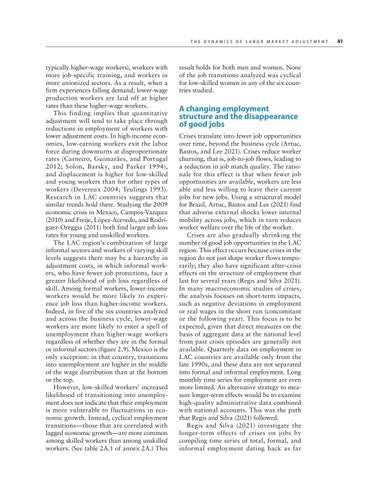T h e D y n a m i c s o f L a b o r M a r k e t Ad j u s t m e n t
typically higher-wage workers), workers with more job-specific training, and workers in more unionized sectors. As a result, when a firm experiences falling demand, lower-wage production workers are laid off at higher rates than these higher-wage workers. This finding implies that quantitative adjustment will tend to take place through reductions in employment of workers with lower adjustment costs. In high-income economies, low-earning workers exit the labor force during downturns at disproportionate rates (Carneiro, Guimarães, and Portugal 2012; Solon, Barsky, and Parker 1994), and displacement is higher for low-skilled and young workers than for other types of workers (Devereux 2004; Teulings 1993). Research in LAC countries suggests that similar trends hold there. Studying the 2009 economic crisis in Mexico, Campos-Vazquez (2010) and Freije, López-Acevedo, and Rodríguez-Oreggia (2011) both find larger job loss rates for young and unskilled workers. The LAC region’s combination of large informal sectors and workers of varying skill levels suggests there may be a hierarchy in adjustment costs, in which informal workers, who have fewer job protections, face a greater likelihood of job loss regardless of skill. Among formal workers, lower-income workers would be more likely to experience job loss than higher-income workers. Indeed, in five of the six countries analyzed and across the business cycle, lower-wage workers are more likely to enter a spell of unemployment than higher-wage workers regardless of whether they are in the formal or informal sectors (figure 2.9). Mexico is the only exception: in that country, transitions into unemployment are higher in the middle of the wage distribution than at the bottom or the top. However, low-skilled workers’ increased likelihood of transitioning into unemployment does not indicate that their employment is more vulnerable to fluctuations in economic growth. Instead, cyclical employment transitions—those that are correlated with lagged economic growth—are more common among skilled workers than among unskilled workers. (See table 2A.1 of annex 2A.) This
result holds for both men and women. None of the job transitions analyzed was cyclical for low-skilled women in any of the six countries studied.
A changing employment structure and the disappearance of good jobs Crises translate into fewer job opportunities over time, beyond the business cycle (Artuc, Bastos, and Lee 2021). Crises reduce worker churning, that is, job-to-job flows, leading to a reduction in job match quality. The rationale for this effect is that when fewer job opportunities are available, workers are less able and less willing to leave their current jobs for new jobs. Using a structural model for Brazil, Artuc, Bastos and Lee (2021) find that adverse external shocks lower internal mobility across jobs, which in turn reduces worker welfare over the life of the worker. Crises are also gradually shrinking the number of good job opportunities in the LAC region. This effect occurs because crises in the region do not just shape worker flows temporarily; they also have significant after-crisis effects on the structure of employment that last for several years (Regis and Silva 2021). In many macroeconomic studies of crises, the analysis focuses on short-term impacts, such as negative deviations in employment or real wages in the short run (concomitant or the following year). This focus is to be expected, given that direct measures on the basis of aggregate data at the national level from past crisis episodes are generally not available. Quarterly data on employment in LAC countries are available only from the late 1990s, and these data are not separated into formal and informal employment. Long monthly time series for employment are even more limited. An alternative strategy to measure longer-term effects would be to examine high-quality administrative data combined with national accounts. This was the path that Regis and Silva (2021) followed. Regis and Silva (2021) investigate the longer-term effects of crises on jobs by compiling time series of total, formal, and informal employment dating back as far
41

